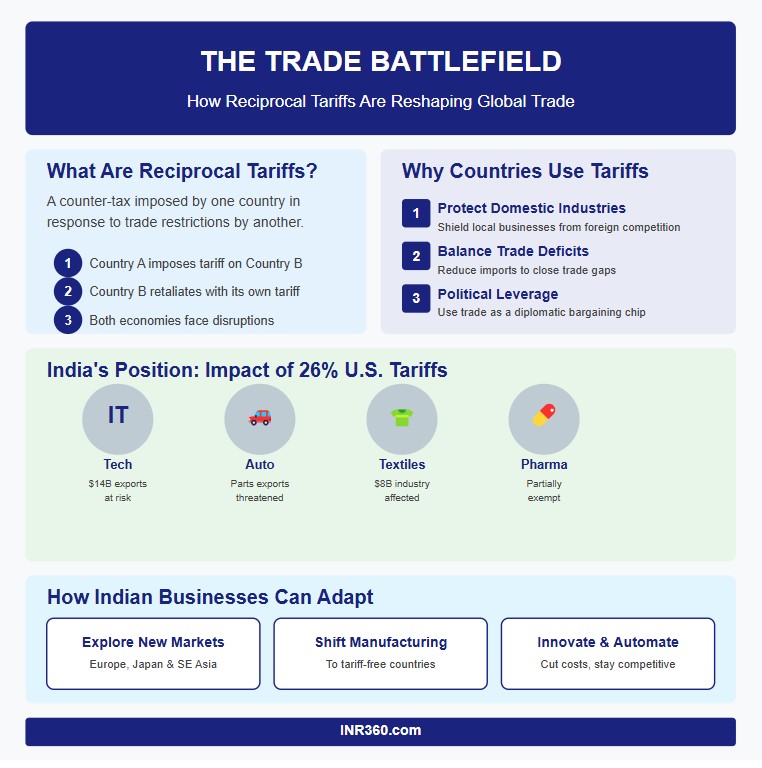Introduction: The Era of Trade Wars and Reciprocal Tariffs
Imagine walking into a market where every vendor charges you the same amount you charge them. If you raise your prices, they do too. That’s exactly how reciprocal tariffs work in international trade.
But what happens when these tariffs escalate into full-blown trade wars?
- Prices rise for businesses and consumers.
- Global supply chains get disrupted.
- Some industries collapse while others thrive.
With Donald Trump’s 2025 tariff hikes, the world is once again entering a phase of economic retaliation, where countries like India, China, and the EU must decide their next move.
Why This Article Matters
This in-depth guide will explain:
✅ What reciprocal tariffs are and how they impact global trade
✅ The winners and losers in trade wars
✅ How India’s economy and businesses will be affected
✅ What Indian exporters and investors should do next
1. What Are Reciprocal Tariffs? A Simple Explanation
A reciprocal tariff is a counter-tax imposed by one country in response to trade restrictions by another. It’s a retaliatory economic weapon used to create “fair” trade conditions.
How Do They Work?
1️⃣ Country A imposes a tariff on imports from Country B.
2️⃣ Country B retaliates with a tariff of its own.
3️⃣ Both economies suffer price hikes and disruptions.
4️⃣ Negotiations or escalations follow, sometimes leading to full-scale trade wars.
Classic Example: The U.S.-China Trade War (2018-2020)
- The Trump administration imposed $360 billion in tariffs on Chinese goods.
- China retaliated with $110 billion in tariffs on U.S. imports.
- Result? A $1.7 trillion loss in global trade and major economic slowdowns.
Now, Trump’s 2025 tariffs are targeting India, China, and several Asian nations. How will this play out?
2. Why Do Countries Use Reciprocal Tariffs?
1. To Protect Domestic Industries
Governments impose tariffs to prevent foreign products from undercutting local businesses.
Example:
- The U.S. steel industry suffered from cheap Chinese imports. Trump’s tariffs helped revive domestic production.
2. To Balance Trade Deficits
A trade deficit occurs when a country imports more than it exports. Tariffs reduce imports, forcing people to buy locally.
Example:
- The U.S. imported $77 billion more from India in 2024 than it exported. Tariffs aim to reduce this gap.
3. Political and Strategic Moves
Trade policies often serve political interests beyond just economics.
Example:
- India imposed tariffs on Chinese goods after border clashes in 2020, impacting China’s electronics and telecom industry.
4. As a Revenue Source
Tariffs are a hidden tax on consumers, as higher import costs lead to higher retail prices.
Example:
- The U.S. collected $85 billion in tariff revenue in 2022.
3. How Do Reciprocal Tariffs Impact Global Markets?
The Winners & Losers of Trade Wars
| Category | Winners | Losers |
|---|---|---|
| Domestic Companies | Local manufacturers benefit from less foreign competition. | Companies that rely on cheap imports. |
| Consumers | Some local brands become stronger. | Prices of imported goods rise. |
| Exporters | Countries that find alternative markets. | Businesses that lose access to key global markets. |
| Governments | Higher short-term tariff revenue. | Long-term trade disruptions & economic slowdown. |
Global Examples of Tariff Wars Gone Wrong
1️⃣ The U.S. Smoot-Hawley Tariff Act (1930)
- Raised U.S. tariffs by 20%.
- Triggered a global trade collapse and worsened the Great Depression.
2️⃣ India’s 2019 Retaliatory Tariffs on the U.S.
- U.S. tariffs on Indian steel (25%) led to India raising tariffs on 28 American goods (almonds, apples, chemicals).
- Result? U.S. lost access to India’s fast-growing market, impacting American farmers.
Now, India faces a new tariff war in 2025. How will it respond?
4. India’s Position in the Global Tariff War
Trump’s 2025 Tariffs on India
The U.S. has imposed a 26% tariff on Indian imports, affecting multiple sectors:
1. Information Technology & Electronics
🚨 Biggest Impacted Sector 🚨
- Indian electronic exports (worth $14 billion) face major cost hikes in the U.S.
- Companies like Tata Electronics & Dixon Technologies will struggle.
2. Automotive Industry
- Auto part exports to the U.S. will become expensive.
- Tata Motors, Mahindra & Mahindra, and Bajaj Auto may see lower U.S. sales.
3. Textiles & Apparel
- India’s $8 billion garment export industry to the U.S. will shrink.
- Bangladesh & Vietnam may take India’s market share.
4. Pharmaceuticals (Partially Exempt)
- Generic drug exports may be spared due to U.S. reliance on Indian medicines.
- However, biotech tariffs could impact companies like Sun Pharma & Dr. Reddy’s.
5. How Indian Businesses Can Adapt & Survive
For Exporters:
✅ Explore new markets like Europe, Japan, and Southeast Asia.
✅ Shift manufacturing bases to tariff-free countries like Vietnam.
✅ Invest in automation to cut costs and remain competitive.
For Policymakers & Investors:
✅ Negotiate new trade deals to bypass U.S. restrictions.
✅ Diversify investments to reduce risk in tariff-affected sectors.
✅ Strengthen domestic supply chains to reduce reliance on U.S. exports.
6. The Future of Reciprocal Tariffs: What Lies Ahead?
🔹 Scenario 1: Trade War Escalates – India retaliates, leading to further U.S. restrictions.
🔹 Scenario 2: Trade Talks Resume – India negotiates with the U.S. for exemptions.
🔹 Scenario 3: Businesses Find Loopholes – Indian companies move production to avoid tariffs.
One thing is certain: India must act fast to secure its trade future.
Conclusion: What’s Next for India in the Global Trade Battlefield?
The 26% U.S. tariff on Indian imports is a turning point. It could either cripple industries or force businesses to innovate.
💡 Final Thought: The countries that adapt to trade wars emerge stronger. India has the talent, technology, and global influence to turn this crisis into an opportunity.
🔥 The real question is: How will India respond?
You Might Also Like To Read: Trade Setup for 3rd April: Can Nifty 50 Defend 23,000, Bank Nifty Hold Above 50,600 Post Trump’s Tariff Move?
Visual Recap: How Reciprocal Tariffs Are Reshaping the Global Economy and India’s Future




